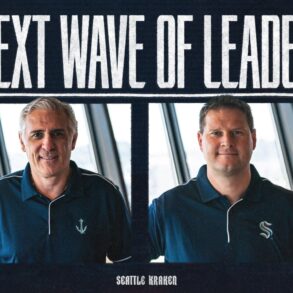The NHL off-season usually brings a mix of excitement and anxiety. For some fans, it’s the time to dream big. For others, it’s all about analyzing trades, new signings, and trying to make sense of how their team stacks up. But this year, there’s a different buzz in the air—thanks to the massive new media rights deal between the NHL and Rogers.
” data-medium-file=”https://prohockeynews.com/wp-content/uploads/2025/03/DSC_6946.jpg” data-large-file=”https://prohockeynews.com/wp-content/uploads/2025/03/DSC_6946.jpg” class=”size-full wp-image-257925″ src=”https://prohockeynews.com/wp-content/uploads/2025/03/DSC_6946.jpg” alt width=”535″ height=”356″>
Owen Tippett #74 of the Philadelphia Flyers carries the puck past Kieffer Bellows #26 and Luke Evangelista #77 of the Nashville Predators Jack.smart@prohockeynews.com
Worth a jaw-dropping $11 billion over 12 years, it’s a game-changer that promises more games, more access, and fewer regional blackouts. It’s the kind of development that could attract additional attention and reshape how fans experience hockey across Canada.
With more fans watching, it’s no surprise that more people are getting curious about how to get involved beyond just cheering from the couch. Whether it’s predicting scores or digging into team stats, fan engagement is shifting.
That shift is perfectly captured in Techopedia’s editorial insights, which break down the various sports betting sites in simple terms. According to Vlad Grindu, these platforms have become a go-to for folks looking for competitive odds, different bet types, and conveniences like payment method flexibility.
This added layer of engagement isn’t new to the world of sports, but it’s growing in hockey. With every new matchup, every highlight-reel goal, and every power play opportunity, fans are finding new reasons to tune in and stay tuned.
That’s exactly the kind of fan involvement the NHL likely had in mind when they struck that enormous deal with Rogers. After all, more airtime doesn’t just mean more exposure. It means more moments for fans to get invested—whether emotionally, statistically, or even financially.
This couldn’t have come at a better time for Canadian hockey. The last few seasons have been unpredictable. Injuries, coaching changes, and the rise of new stars have made the league harder than ever to predict. For instance, the Maple Leafs are still chasing that elusive playoff breakthrough, the Oilers continue to build around McDavid and Draisaitl, and teams like the Senators and Canucks are trying to prove they can hang with the big guys. With all this movement, fans aren’t just watching—they’re talking, reading, and yes, placing bets on what’s going to happen next.
What’s also exciting is that this growing involvement seems to be drawing in a wider range of fans. It’s not just the traditional crowd anymore. People who may have tuned in only during playoffs are now watching regular-season games. The NHL’s wider coverage and better streaming options—both promised under the new Rogers deal—mean fans can catch their favourite team more often, no matter where they live.
With that accessibility comes curiosity: Who’s the underdog? What do the odds say? How does this goalie match up against that forward line?
Of course, it’s not just fans who are paying attention. Analysts, reporters, and even players know that public interest is shifting. NHL broadcasts are starting to incorporate more data, stats, and player tracking info. It’s becoming normal to talk about expected goals, power-play efficiency, and faceoff win percentages.
This shift towards a more informed fanbase doesn’t just make the games more fun to watch—it adds depth. It fits right in with the idea of fans making informed decisions, whether it’s about fantasy hockey picks or something more high-stakes.
This kind of evolution doesn’t happen overnight. It takes big moves from big organizations. The NHL’s commitment to expanding access through its Rogers deal is a step in that direction. So is the rise in platforms that help educate fans, like the betting guide mentioned earlier. And while not everyone will become an expert, it’s clear that today’s average fan is a lot more clued-in than they were ten years ago.
What’s really promising is how this all blends together: media, engagement, and accessibility. Take a typical Saturday night during the season. A Canadian family sits down to watch a game that’s now nationally broadcast, thanks to Rogers. The game features two teams fighting for a playoff spot. Stats flash across the screen, offering insights into recent form and injury updates.
At the same time, fans are chatting online, reading breakdowns, or looking up the odds before puck drop. Some are just watching, while others are playing fantasy. A few might be placing a bet or two. And that variety of engagement? That’s the new normal.https://ldeaffinityjewelry.com/
” data-image-caption data-medium-file=”https://prohockeynews.com/wp-content/uploads/2021/01/DMnNDUxV.jpg-medium-200×25.jpg” data-large-file=”https://prohockeynews.com/wp-content/uploads/2021/01/DMnNDUxV.jpg-medium.jpg” class=”aligncenter size-full wp-image-168188″ src=”https://prohockeynews.com/wp-content/uploads/2021/01/DMnNDUxV.jpg-medium.jpg” alt width=”1000″ height=”125″ srcset=”https://prohockeynews.com/wp-content/uploads/2021/01/DMnNDUxV.jpg-medium.jpg 1000w, https://prohockeynews.com/wp-content/uploads/2021/01/DMnNDUxV.jpg-medium-200×25.jpg 200w, https://prohockeynews.com/wp-content/uploads/2021/01/DMnNDUxV.jpg-medium-768×96.jpg 768w, https://prohockeynews.com/wp-content/uploads/2021/01/DMnNDUxV.jpg-medium-500×63.jpg 500w” sizes=”(max-width: 1000px) 100vw, 1000px”>
Hockey has always been part of Canada’s identity, but now it’s also becoming a part of how people connect with data, with media, and with each other. The game itself isn’t changing—the ice, the goals, the rivalries all stay the same. But the way people interact with it is evolving fast.
And that’s something worth keeping an eye on as the next season rolls around.
This post was originally published on this site be sure to check out more of their content.







